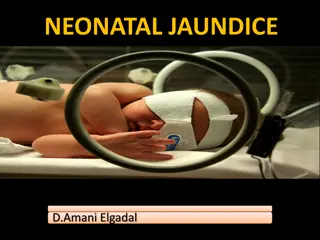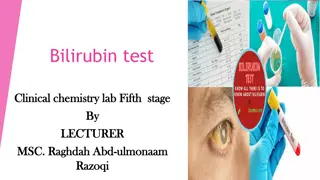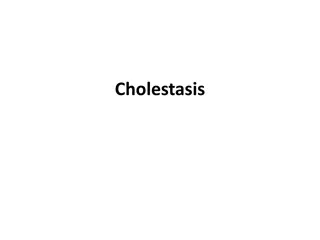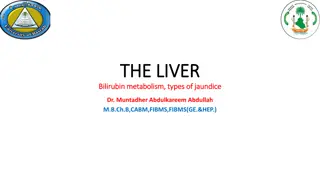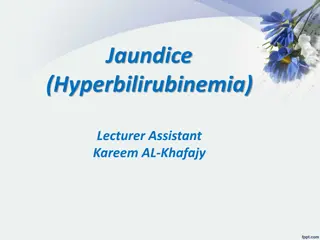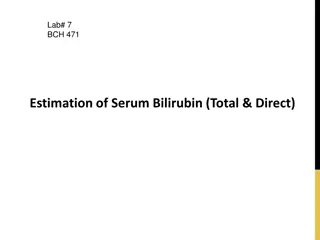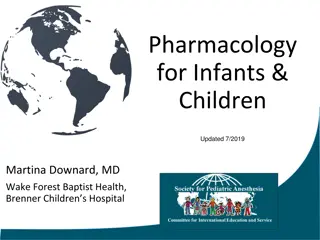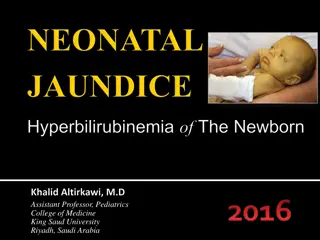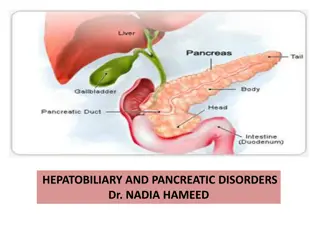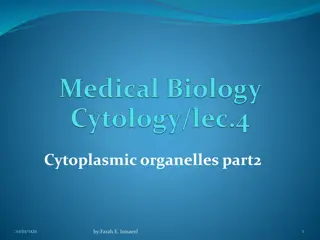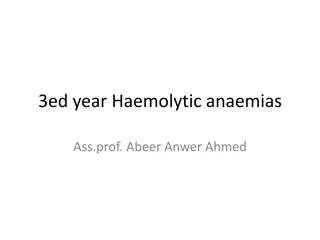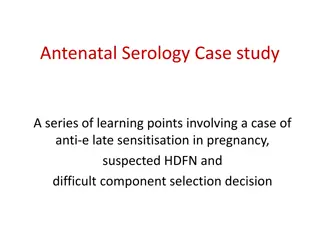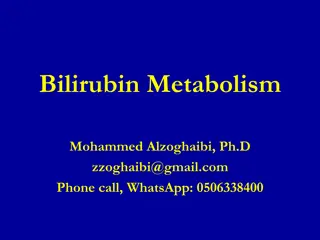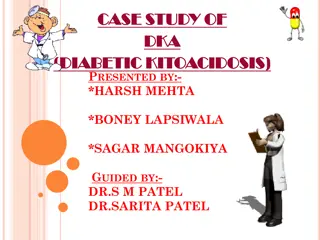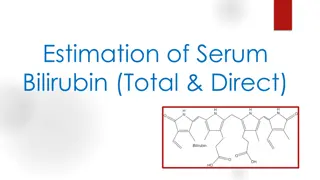Understanding Liver Function Tests in Cholestatic Injury
Cholestatic liver disease affects Alkaline Phosphatase (ALP) and bilirubin levels, indicating bile duct damage. GGT and 5'-Nucleotidase help differentiate hepatobiliary vs. bone origin of ALP elevation. ALP is produced by bile duct epithelium and can be normal in acute biliary obstruction. GGT and N
1 views • 33 slides
NEONATAL JAUNDICE
Neonatal jaundice, a common condition in newborns, results from elevated bilirubin levels. While often benign, high levels can lead to complications like kernicterus. Recognizing risk factors, limitations of clinical assessment, and appropriate evaluation and treatment are crucial in managing neonat
1 views • 48 slides
Understanding Bilirubin: What You Need to Know
Bilirubin is a yellowish substance formed during the breakdown of red blood cells, traveling through the liver before excretion. High levels indicate hyperbilirubinemia, often signaling underlying health issues. It's a common occurrence in newborns as well. The compound plays a crucial role in the b
0 views • 19 slides
Understanding Cholestasis: Etiology, Clinical Manifestations, and Complications
Cholestasis is characterized by reduced bile flow and elevated direct bilirubin. It is critical to differentiate it from neonatal jaundice. In conditions like biliary atresia and 1-antitrypsin deficiency, early diagnosis and intervention are crucial to prevent liver failure. Clinical manifestations
5 views • 14 slides
Understanding Bilirubin Metabolism and Different Types of Jaundice
Explore the detailed information about bilirubin metabolism and various types of jaundice, including their clinical presentations, etiologies, and management strategies. Learn to differentiate between different types of jaundice based on case scenarios and understand the functional anatomy and physi
0 views • 33 slides
Understanding Hyperbilirubinemia in Infants - A Comprehensive Overview
This educational content delves into hyperbilirubinemia, focusing on its definition, causes, metabolic processes, associated complications, and treatment options like phototherapy and exchange blood transfusion. Key topics covered include physiologic jaundice, the seriousness of unconjugated bilirub
0 views • 16 slides
Understanding Bilirubin: Estimation, Implications, and Causes of Jaundice
Bilirubin, a yellow compound in the catabolic pathway, plays a crucial role in health. Estimating serum bilirubin levels is key in diagnosing conditions like jaundice. Elevated levels, above 2 mg/dl, can indicate disease. Jaundice, characterized by skin and eye discoloration, has pre-hepatic, hepati
0 views • 16 slides
Pediatric Pharmacology Update: Perioperative Medications in Infants and Children
Gain insights on frequently used medications in the perioperative period for infants and children, including anesthesia medications. Explore pharmacokinetics, drug distribution in neonates, and the effects of common anesthesia agents on pediatric patients. Understand how immature kidney or liver fun
0 views • 43 slides
Understanding Choledocholithiasis: Causes, Symptoms, and Diagnosis
Choledocholithiasis, the presence of stones in the common bile duct, is a common condition found in a percentage of patients with gallstones. The stones can be primary or secondary, causing a range of clinical manifestations from silent obstruction to cholangitis or gallstone pancreatitis. Diagnosis
0 views • 40 slides
Understanding Neonatal Jaundice: A Guide for Medical Students
This presentation by Dr. Khalid Altirkawi, M.D., Assistant Professor of Pediatrics, aims to educate medical students on neonatal jaundice. The content covers metabolic pathways of bilirubin, types of jaundice, diagnostic tests, prevention, and treatment strategies. It provides valuable insights into
0 views • 52 slides
Understanding Hepatobiliary and Pancreatic Disorders with Dr. Nadia Hameed
Hepatobiliary and pancreatic disorders can lead to conditions like jaundice, caused by an accumulation of bilirubin. Jaundice can be classified as prehepatic, intrahepatic, or posthepatic depending on the underlying causes such as liver damage, hepatitis, cirrhosis, or bile duct obstructions. Liver
0 views • 26 slides
Functions and Medical Applications of Smooth Endoplasmic Reticulum (SER)
Smooth Endoplasmic Reticulum (SER) is a vital organelle involved in various cellular functions such as synthesizing phospholipids, detoxifying drugs, producing hormones, and aiding in lipid metabolism. Its role in processing bilirubin helps prevent jaundice, with implications for newborn health. The
0 views • 28 slides
Understanding Haemolytic Anaemias: Causes and Classification
Haemolytic anaemias result from increased red cell destruction, involving normal red cell breakdown processes like extravascular removal by macrophages. This breakdown leads to the liberation of iron, bilirubin circulation, and protein synthesis. An introduction to haemolytic anaemias explains how t
0 views • 27 slides
Management of Anti-e Late Sensitization in Pregnancy: A Case Study
A detailed case study involving a pregnant patient with anti-e late sensitization, suspected HDFN, and challenging component selection decisions. The patient's history, serology results, obstetric background, and sequence of events leading to an urgent transfer of the infant to a specialized hospita
0 views • 15 slides
Understanding Bilirubin Metabolism in Human Body
Bilirubin, a key pigment in bile, is derived from heme breakdown and plays a crucial role in the liver's detoxification process. This article explores the metabolism of bilirubin, its relationship with heme and globin, as well as its excretion steps involving enzymatic reactions and conjugation in h
0 views • 31 slides
Case Study of Diabetic Ketoacidosis (DKA) in a 5-Year-Old Female Patient
A case study on a 5-year-old female patient admitted with symptoms of pain in the right ear, neck, vomiting, and fever. The patient initially sought treatment for ear pain at another hospital before becoming unconscious and being brought to a civil hospital. Biochemistry results revealed abnormaliti
0 views • 39 slides
Understanding Serum Bilirubin: Types, Estimation, and Causes of Jaundice
Serum bilirubin levels are crucial in diagnosing conditions like jaundice, with total, direct, and indirect bilirubin playing key roles. Excess bilirubin in the blood can lead to jaundice, characterized by yellow discoloration of the skin and eyes. Different types of jaundice, including pre-hepatic,
0 views • 14 slides

